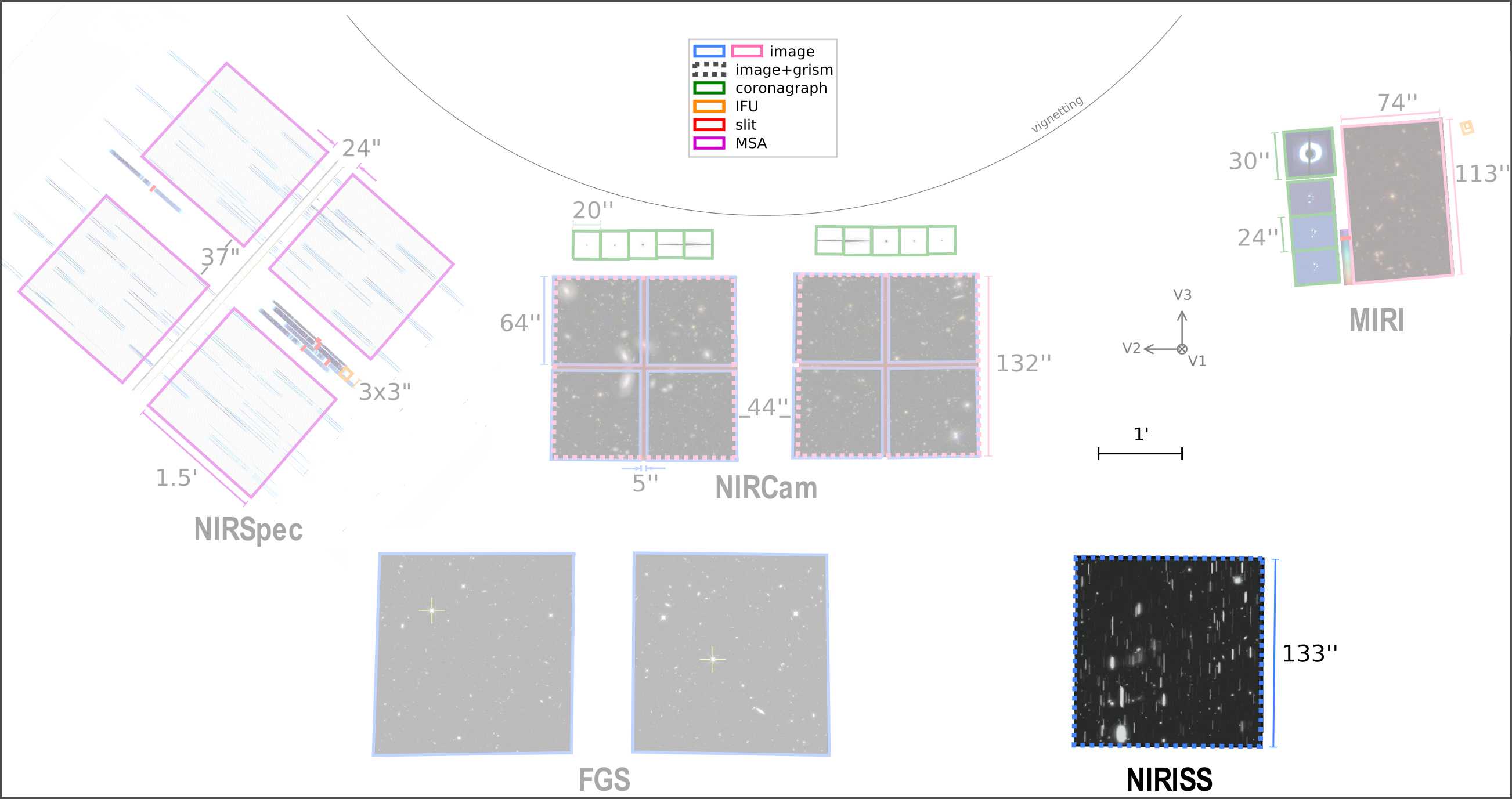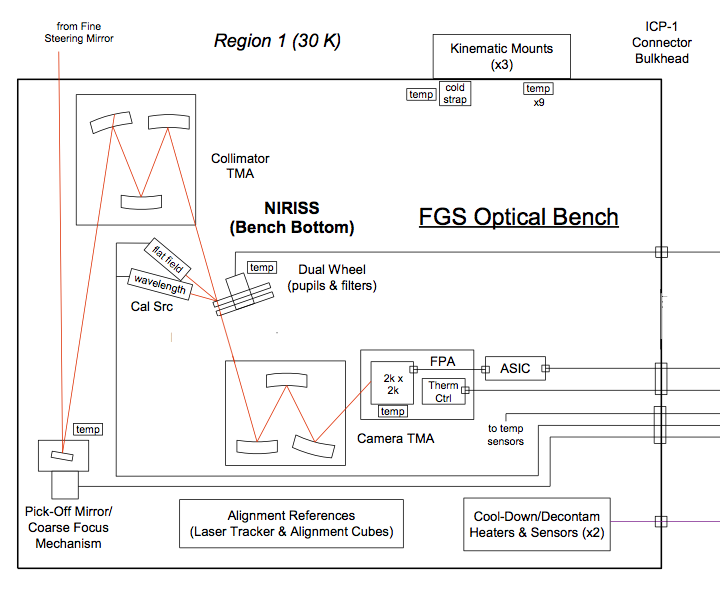JWST Near Infrared Imager and Slitless Spectrograph
The JWST Near Infrared Imager and Slitless Spectrograph (NIRISS) provides observing modes for slitless spectroscopy, high-contrast interferometric imaging, and imaging, at wavelengths between 0.6 and 5.0 μm over a 2.2' x 2.2' FOV.
NIRISS logo courtesy of Canadian Space Agency
On this page
Although NIRISS is packaged with the Fine Guidance Sensor (FGS), the 2 instruments are functionally independent of each other.
Observational capabilities
When used in specific combinations, optical elements in the NIRISS pupil and filter wheel enable 4 observing modes:
Wide field slitless spectroscopy (WFSS) over the entire field of view, using one or both of a pair of identical grisms and a selection of blocking filters to isolate specific wavelength intervals between 0.8 and 2.2 μm. The grisms are mounted to disperse light in orthogonal directions on the detector.
- Single object slitless spectroscopy (SOSS) with a cross-dispersed grism designed to deliver broad wavelength coverage and spectro-photometric stability, optimized for time-series observations (TSOs).
- Aperture masking interferometry (AMI) through specific filters, enabled by a mask with 7 sub-apertures.
- Imaging in 7 wide- and 5 medium-band filters that are closely matched to the NIRCam filter set between 0.9 and 5.0 μm.
Table 1. Specific properties of NIRISS observing modes
Observing | Wavelength | Field of | Pixel scale | Resolving power | FWHM | Comment |
|---|---|---|---|---|---|---|
| 0.8–2.2 | 133 × 133 | 0.066"/pixel | 150 @ 1.4 μm | ... | Orthogonal dispersion | |
0.6–2.8 | ... | 0.066"/pixel | 700 @ 1.4 μm | ... | Subarrays are standard; full frame allowed | |
| Aperture masking interferometry (AMI) | 2.8–4.8 | 5.2 × 5.2 | 0.066"/pixel | ... | ... | Subarray is standard; full frame allowed |
| Imaging | 0.8–5.0 | 133 × 133 | 0.066"/pixel | 4–10 | F380M filter and longer wavelength filters are Nyquist sampled | Full frame standard |
Optical elements
The optical path of NIRISS is illustrated schematically in Figure 2a. A solid-body representation of the instrument is shown in Figure 2b.
Light from the Optical Telescope Element of JWST is processed sequentially by:
- a pick-off mirror
- a collimator (3 reflections)
- a user-selected element in the pupil wheel
- a user-selected element in the filter wheel
- a camera (3 reflections)
- a detector in the focal plane assembly
© Honeywell
© Honeywell
Four observing modes are enabled by specific combinations of the 9 optical elements in the pupil and filter wheels. Allowed combinations are indicated in Table 2.
Table 2. Allowed combinations of optical elements for 4 observing modes
Observing mode | Allowed pupil | Allowed filter |
|---|---|---|
F090W F115W F150W F200W F140M F158M | GR150C GR150R | |
| Single object slitless spectroscopy (SOSS) | GR700XD | CLEAR |
NRM | F277W F380M F430M F480M | |
Imaging (0.9 μm to 2.0 μm) Imaging (2.7 μm to 4.8 μm) | F090W F115W F150W F200W F140M F158M CLEARP | CLEAR F277W F356W F444W F380M F430M F480M |
NIRISS has a single Teledyne H2RG detector with 2040 × 2040 pixels sensitive to light. The pixels, measuring 18 μm on a side, are made of HgCdTe with a composition tuned to provide a long wavelength cutoff near 5.2 μm. In its full frame format, the detector is read out non-destructively every 10.74 s through 4 readout channels. Subarray formats are available for most modes to decrease the readout time. The smallest subarray (64 × 64 pixels, used for target acquisition) can be read out in 50.16 ms.
Sensitivity and performance
Please consult the JWST Exposure Time Calculator for definitive estimates of performance in each observing mode.
Wide field slitless spectroscopy (WFSS)
Single object slitless spectroscopy (SOSS)
Table 3 lists the J-band magnitude for which saturation first occurs in the specified order, with the specified number of samples "up the ramp" (Ngroups) for the subarrays available for use with SOSS.
Table 3. SOSS saturation limits for a G2 V spectrum
| Subarray | Subarray size | Order | NGroups | J mag (Vega)† |
|---|---|---|---|---|
| SUBSTRIP256 | 256 × 2048 | 1 | 2 | 8.4 |
| SUBSTRIP256 | 256 × 2048 | 2 | 2 | 6.3 |
| SUBSTRIP96 | 96 × 2048 | 1 | 2 | 7.4 |
† Reported magnitudes are simulated 2MASS J-band magnitudes. The bright limit varies as a function of wavelength and spectral type.
Aperture masking interferometry (AMI)
Words in bold are GUI menus/
panels or data software packages;
bold italics are buttons in GUI
tools or package parameters.
Table 4 lists the bright limits for AMI for the SUB80 subarray.
Table 4. AMI saturation limits in Vega magnitudes for an A0V type star.
| Filter† | Magnitude NGroups=1 | Magnitude NGroups=2 |
|---|---|---|
| F227W | 7.2 | 8.0 |
| F380M | 4.4 | 5.1 |
| F430M | 3.7 | 4.5 |
| F480M | 3.4 | 4.1 |
Table notes:
The magnitude in NIRISS filters are equivalent to the previous "Vegamag" system where the CALSPEC Sirius model from Bohlin 2022 is used as a template for an A0V star with a magnitude of -1.395 in all filters (Rieke et al. 2022). Note that quoted bright limits will vary for different spectral types.
†The magnitudes in NIRISS filters F277W and F380M roughly correspond to the WISE W1 magnitude.The magnitudes in NIRISS filters F430M and F480M roughly correspond to the WISE W2 magnitude. There is a ±0.05 magnitude uncertainty due to the conversion from NIRISS magnitude to WISE magnitudes, which is a function of the spectral shape of the source. The magnitudes of the WISE and NIRISS filters should match for an average A0V star and WISE magnitudes are predicted to be slightly smaller than the NIRISS magnitudes for later spectral types.
Imaging
Table 5 lists the estimated point source sensitivity for imaging through broadband filters. The limits are expressed as the limiting flux achieved with S/N = 10 in an integration of 10 ks.
Table 5. Filter point source imaging sensitivity for S/N = 10 in 10ks
| Filter | Flux density (nJy) | Magnitude† (Sirius) |
|---|---|---|
| Pupil Wheel Filters | ||
| F090W | 15.9 | 27.9 |
| F115W | 14.1 | 27.8 |
| F140M | 19.2 | 27.1 |
| F150W | 12.8 | 27.4 |
| F158M | 17.8 | 27.0 |
| F200W | 11.3 | 27.1 |
| Filter Wheel Filters | ||
| F227W | 11.5 | 26.4 |
| F356W | 12.3 | 25.9 |
| F380M | 32.6 | 24.7 |
| F430M | 43.2 | 24.1 |
| F444W | 18.8 | 25.0 |
| F480M | 54.1 | 23.6 |
† The magnitude in NIRISS filters are equivalent to the previous "Vegamag" system where the CALSPEC Sirius model from Bohlin 2022 is used as a template for an A0V star with a magnitude of -1.395 in all filters (Rieke et al. 2022).
More about NIRISS
External NIRISS links and documents
Lectures
JWST Community Lecture Series - NIRISS Overview (R. Doyon)
Acknowledgements
NIRISS is a contribution by the Canadian Space Agency to the JWST Project. The principal investigator of NIRISS is Professor René Doyon of the Université de Montréal. Honeywell International designed and built the instrument, with additional technical support from the National Research Council of Canada.
References
Doyon, R., et al. 2012, SPIE, 8442, 2RD
The JWST Fine Guidance Sensor (FGS) and Near-Infrared Imager and Slitless Spectrograph (NIRISS)
Doyon, R. JWST Community Webinar Series (2016 April 19)
NIRISS Overview
Kammerer, J., Cooper, R. A., Vandal., T., et al. 2022, arXiv:2210.17528
The Near Infrared Imager and Slitless Spectrograph for JWST – V. Kernel Phase Imaging and Data Analysis
Sivaramakrishnan, A., Tuthill, P., Loyd, J. P. et al. 2022, arXiv:2210.17434
The Near Infrared Imager and Slitless Spectrograph for the James Webb Space Telescopes – IV. Aperture Masking Interferometry
Willott, C. J., Doyon, R., Albert, L., et al. 2022, PASP, 134, 1032
The Near-Infrared Imager and Slitless Spectrograph for the James Webb Space Telescope. II. Wide Field Slitless Spectroscopy







